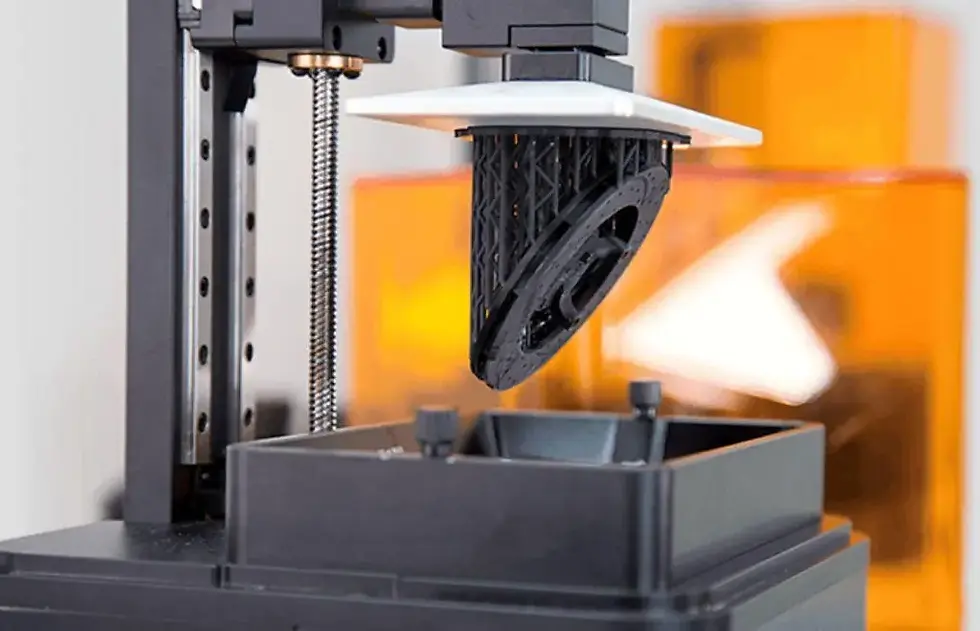SLA (Stereolithography) 3D Printing - An Overview
- Locanam 3D Printing

- Mar 19, 2024
- 3 min read
Updated: May 17, 2024

SLA (stereolithography) is the Major technology of 3D printing. Learn all about How the SLA technology works.
Stereolithography, also called as SLA, stands out as a groundbreaking technology within the activities of additive manufacturing, specifically belonging to the Vat Photopolymerization category. It's acknowledged globally for its exceptional precision and versatility in 3D printing.
SLA functions through a method known as photopolymerization, wherein a laser or similar light source is employed to selectively solidify liquid resin into structured objects layer by layer, adhering closely to a digitally rendered design. This process yields remarkably detailed, complex, and precise 3D prints. SLA is one of the major 3d printing technologies, same as Fused deposition modeling (FDM) and selective laser sintering (SLS). It It belongs to the vat polymerization category, which is also known as resin 3D printing and includes newer technologies such as digital light processing (DLP) and liquid crystal display based (LCD) resin 3D printing. In this article, we’ll discuss the basics of SLA 3D printing as well as compare it with other popular technologies.
History of SLA 3D PRINTING

Although not as widely discussed in hobbyist circles compared to FDM technology, SLA stands out as the oldest form of additive manufacturing and holds significant sway in industrial applications. Its origins trace back to 1986 when Chuck Hull, the founder of 3D Systems, coined the term and developed the technology. Essentially, SLA involves crafting 3D objects through the gradual layering and curing of photosensitive materials.
SLA was the first entry into the rapid prototyping field during the 1980s and has continued to advance itself into a widely used technology. A milestone was achieved in 1992 when 3D Systems introduced the inaugural SLA apparatus globally. This innovation revolutionized manufacturing by enabling the rapid fabrication of intricate components within significantly reduced timeframes. Despite the advent of various additive processes since its inception, SLA retains its position as the premier method for producing intricately detailed parts with exceptionally smooth surface finishes.
Stereolithography (SLA) 3D Printing Workflow

Design Softwire Utilize CAD software or leverage 3D scanning data to meticulously craft your model. Subsequently, export the design into a compatible 3D printable file format, such as STL or OBJ. The accompanying software tailored to each SLA printer facilitates customization of printing configurations and segmentation of the digital model into printable layers. Once configured, the print preparation software establishes a connection with the printer either wirelessly or via cable to initiate the printing procedure.
Printing
When the manufacturing process initiates, a laser is employed to project a specific pattern referred to as a "layer" within a reservoir. This laser beam induces solidification wherever it intersects with the liquid material. This photopolymerization process necessitates only two components: the laser, which emits photons, and the liquid plastic.
Guided by a computer-controlled mirror system known as a "galvanometer" or "galvo" for short, the laser is precisely directed to the designated coordinates.
Subsequent to the formation of the initial layer, the platform is incrementally raised in accordance with the predetermined layer thickness, typically around 0.1 mm. Additional resin is then introduced to fill the space below the previously solidified portion. In practice, the platform often undergoes more extensive movement to facilitate the flow of the viscous resin. The laser proceeds to solidify the subsequent cross-section, repeating this cycle until the entire component is fabricated. Any remaining resin untouched by the laser remains in the reservoir and can be reclaimed for future use.
Post-Process

Once the 3D printing is completed, the platform emerges from the tank. Following this, the object is taken off the platform, cleaned of surplus resin using alcohol, and subsequently placed in a UV curing chamber. Post-print curing is essential for enhancing the strength and stability of the objects. This method enables the layers to cure effectively with minimal power consumption, thus expediting the entire process.
Conclusion
Stereolithography (SLA) is an innovative method in additive manufacturing, specifically within the Vat Photopolymerization category. This technology is revolutionizing 3D printing by offering exceptional precision and flexibility for professionals across different sectors. Whether you're a professional looking for high precision or an enthusiast exploring the possibilities of 3D printing, SLA presents exciting opportunities. With SLA, individuals can unlock new realms of creativity and innovation previously inaccessible.



Comments